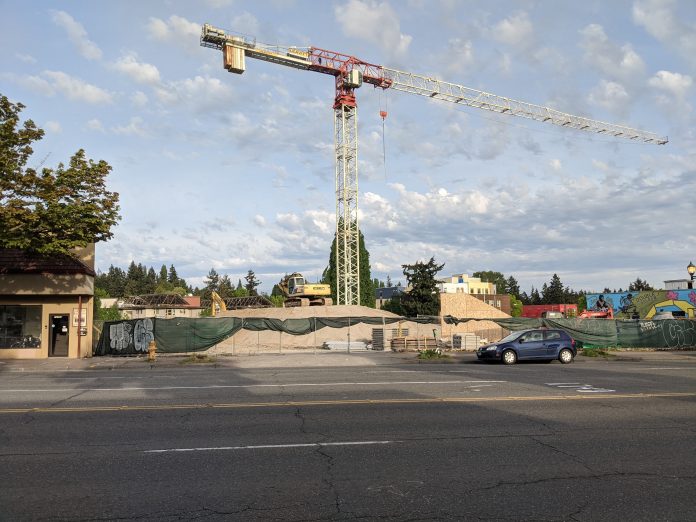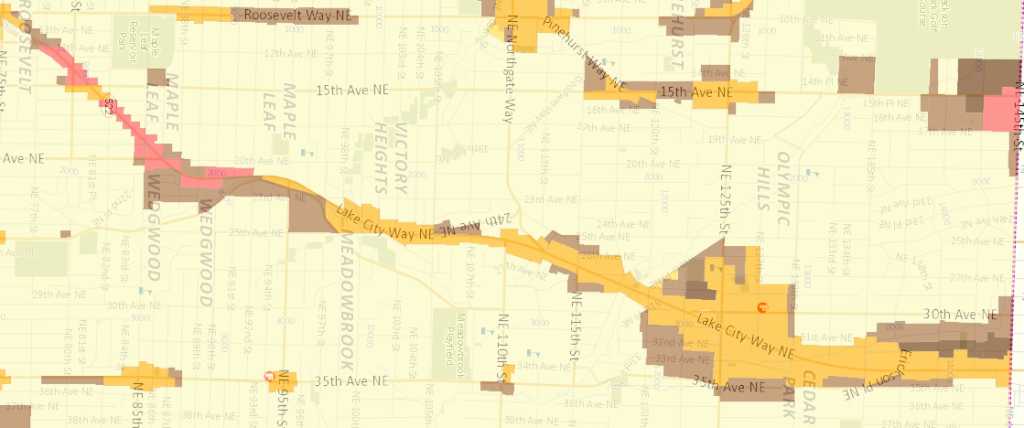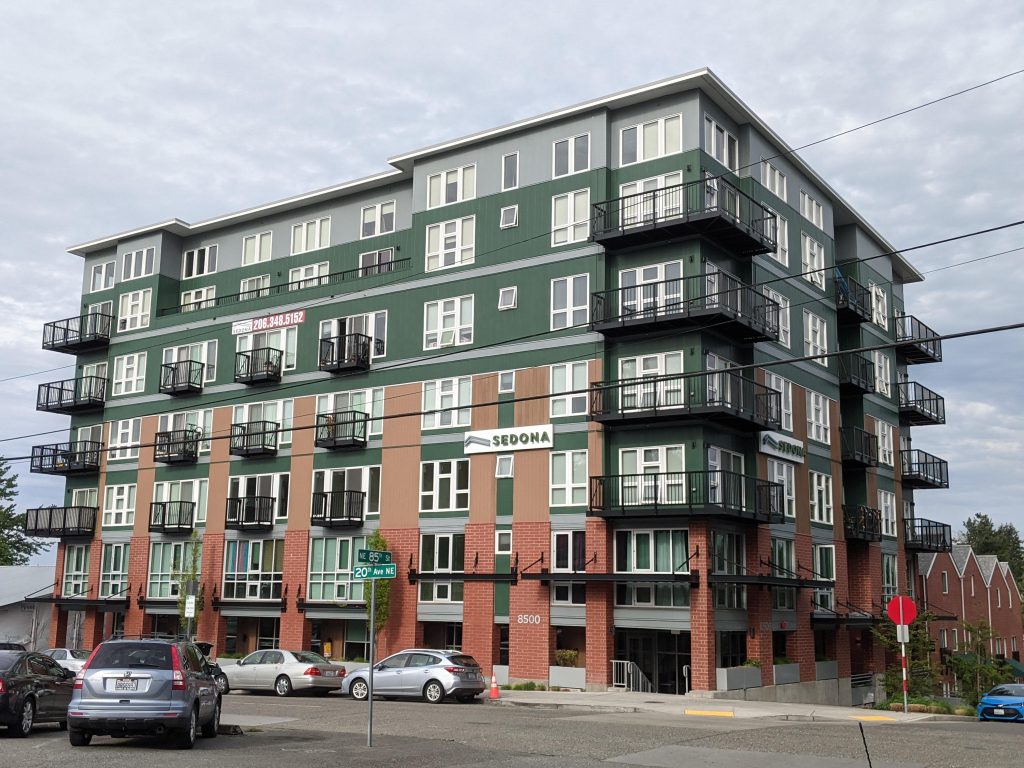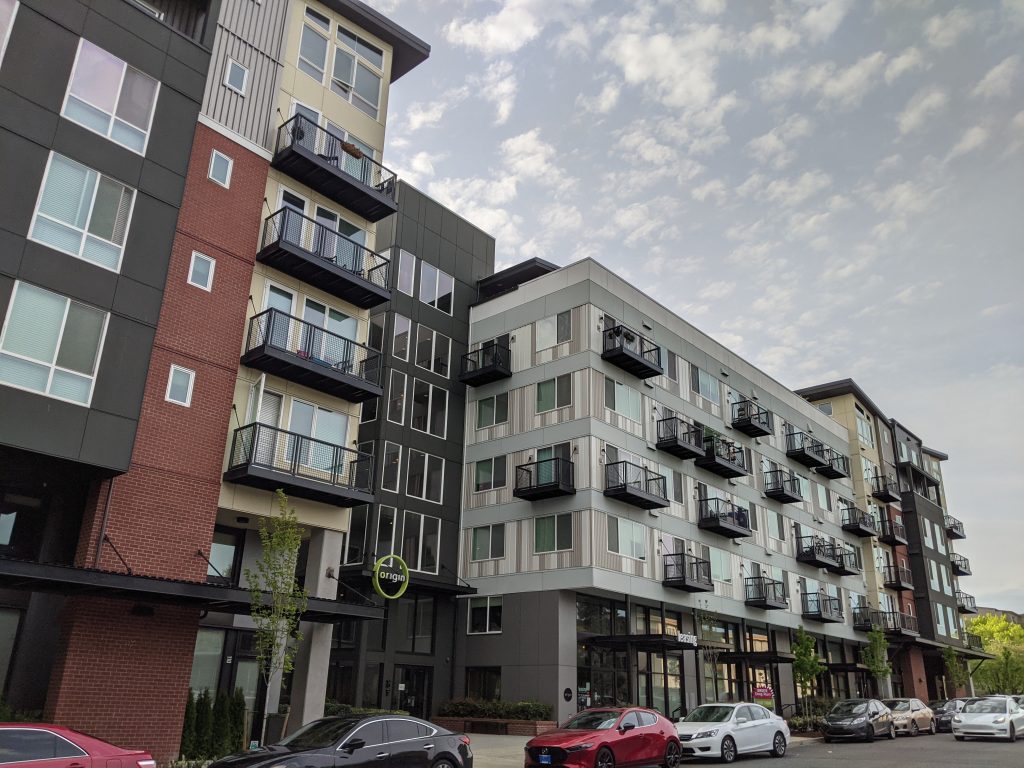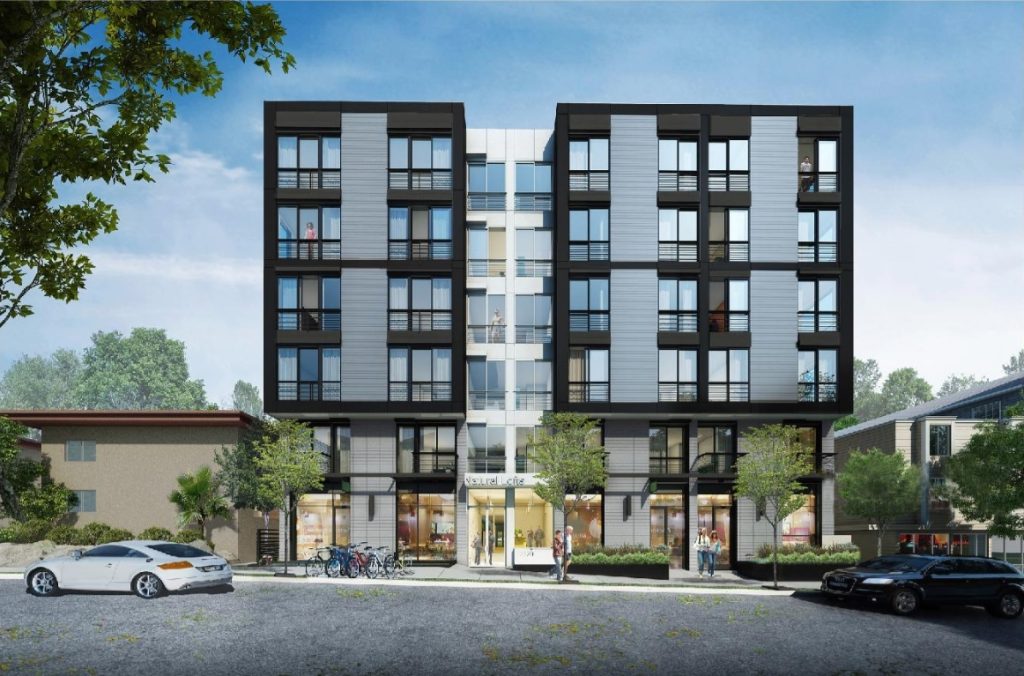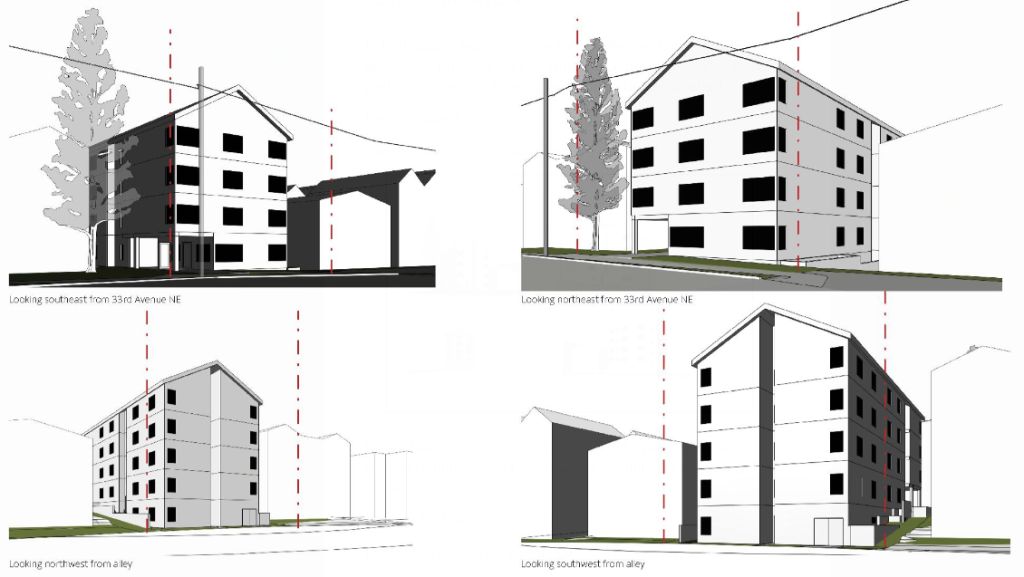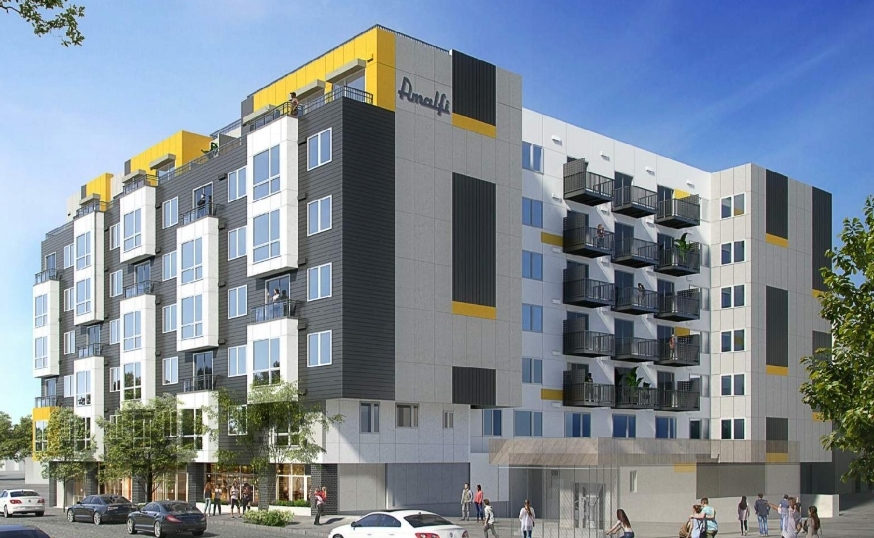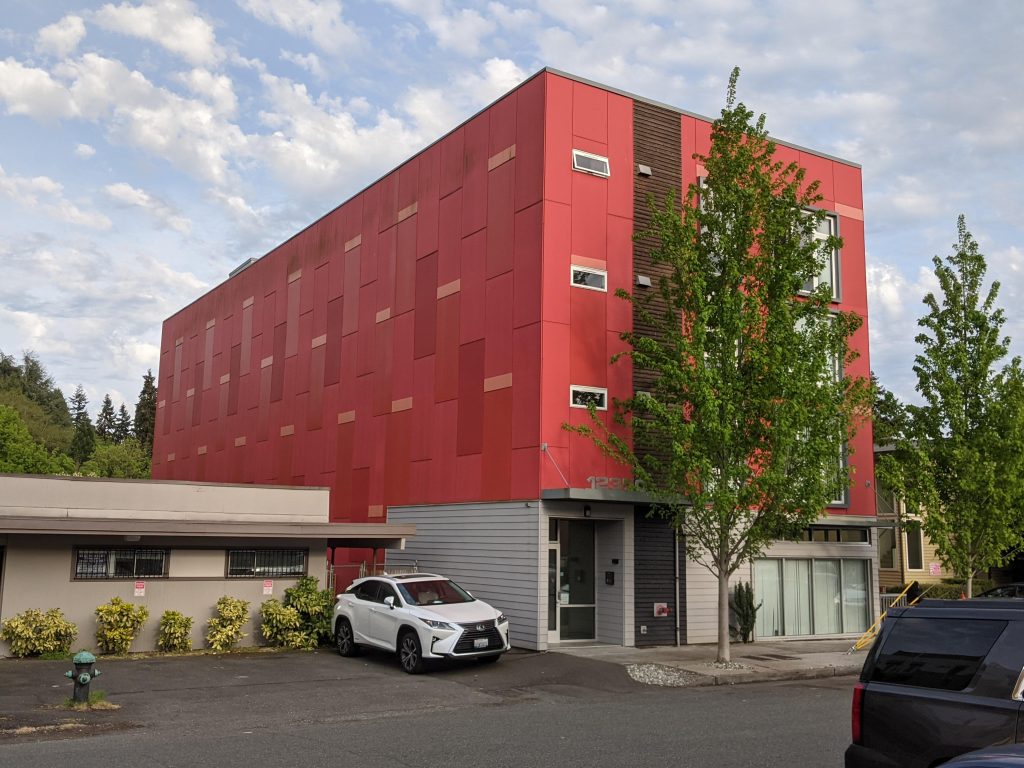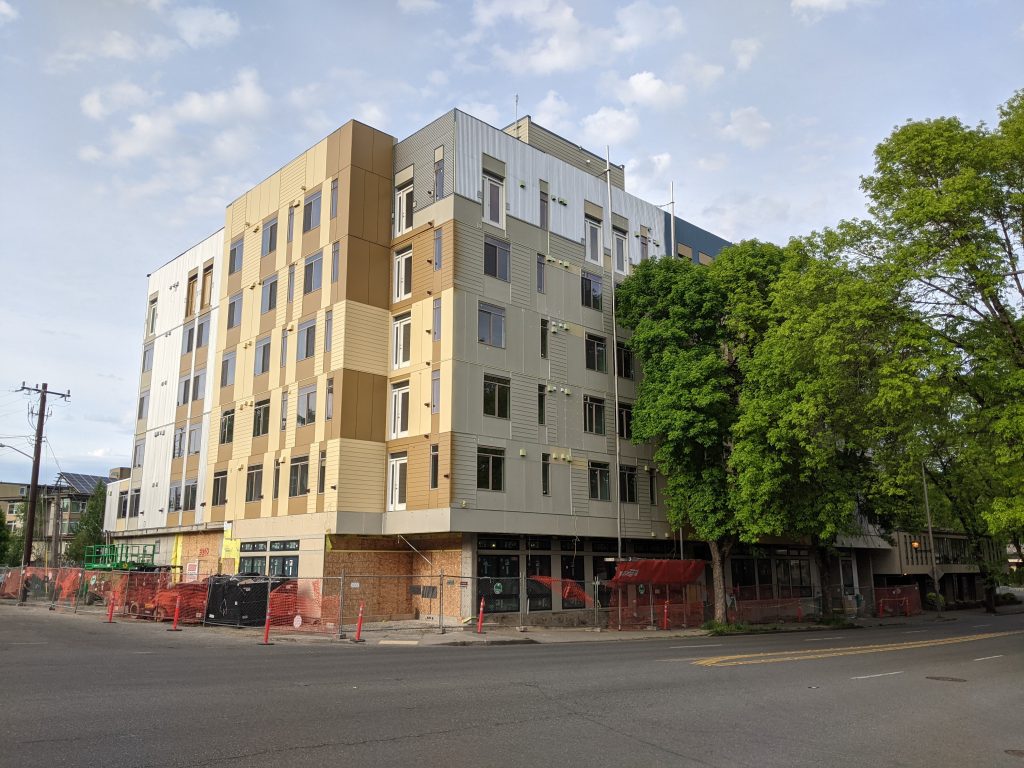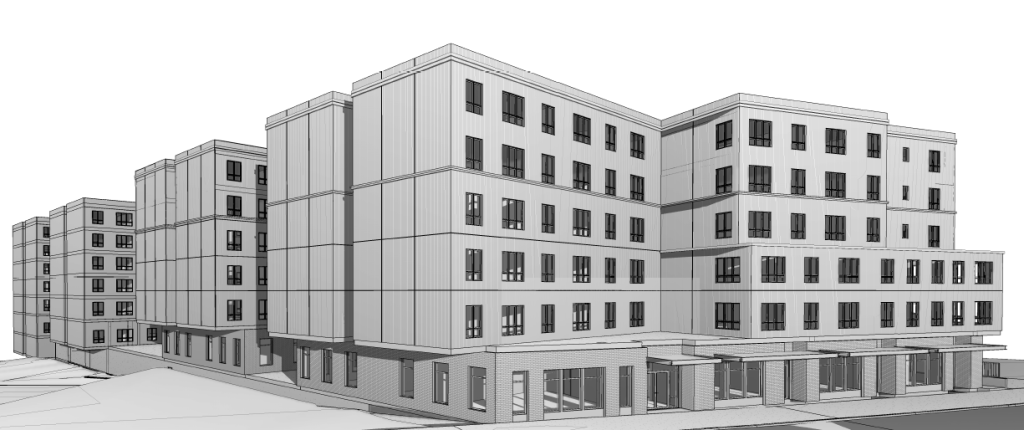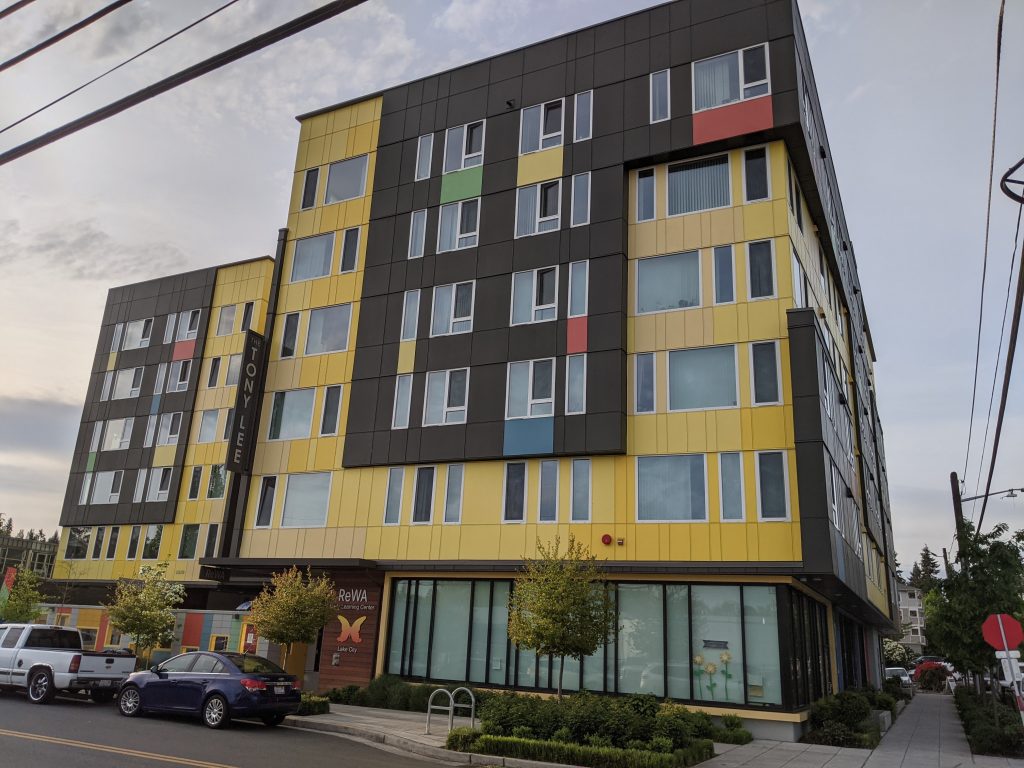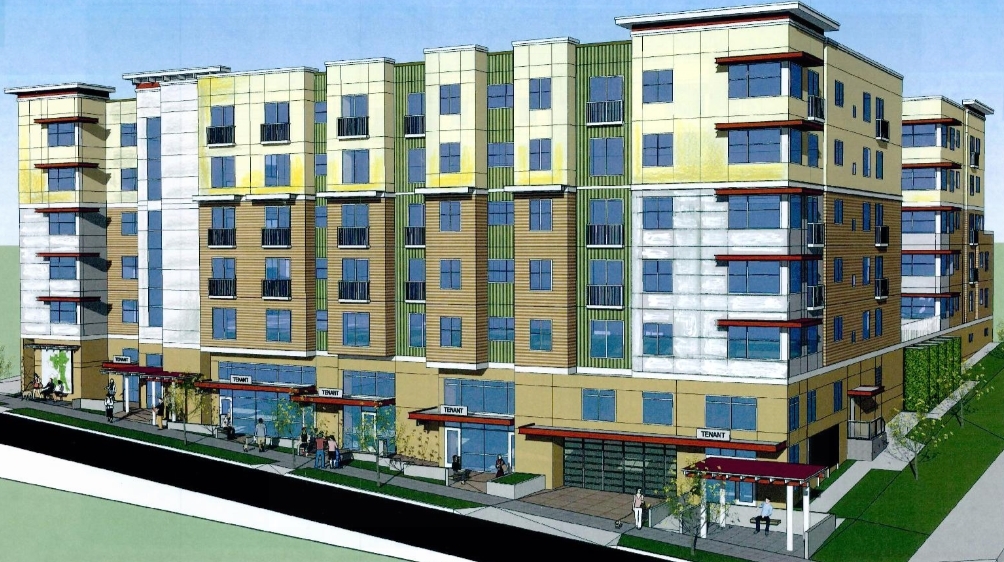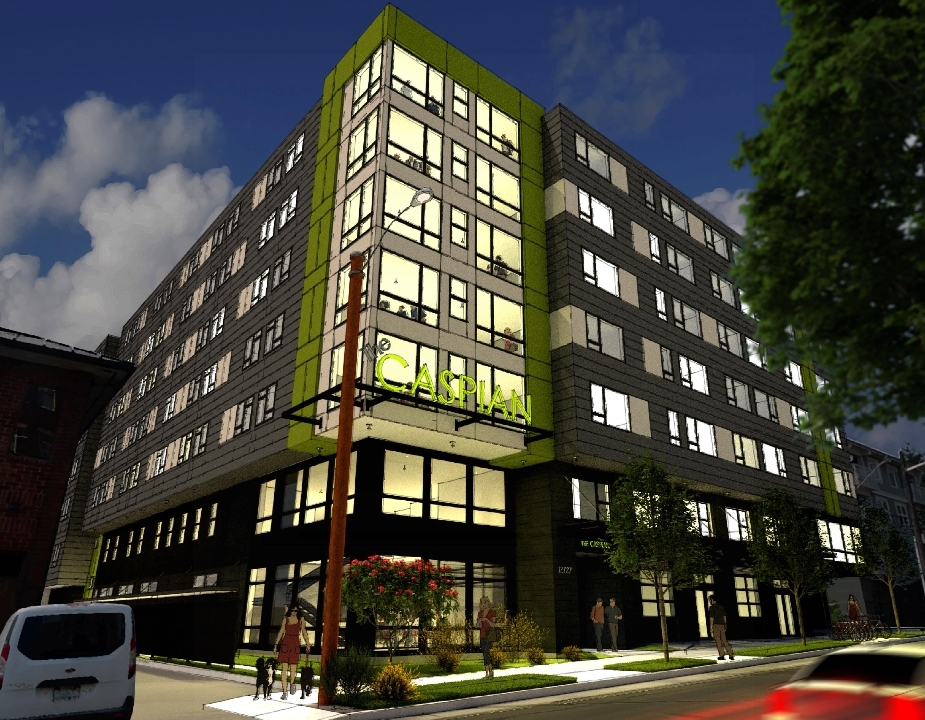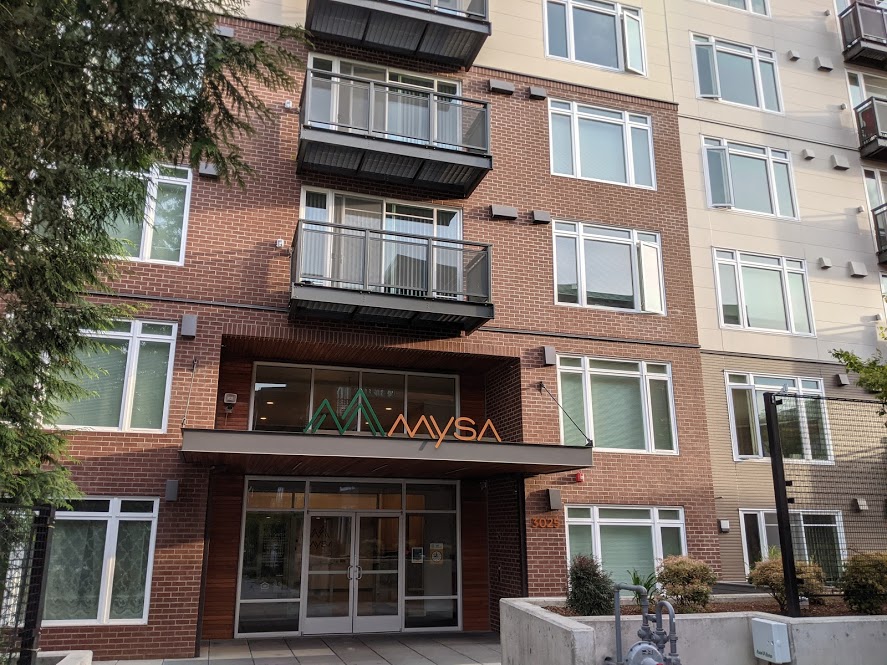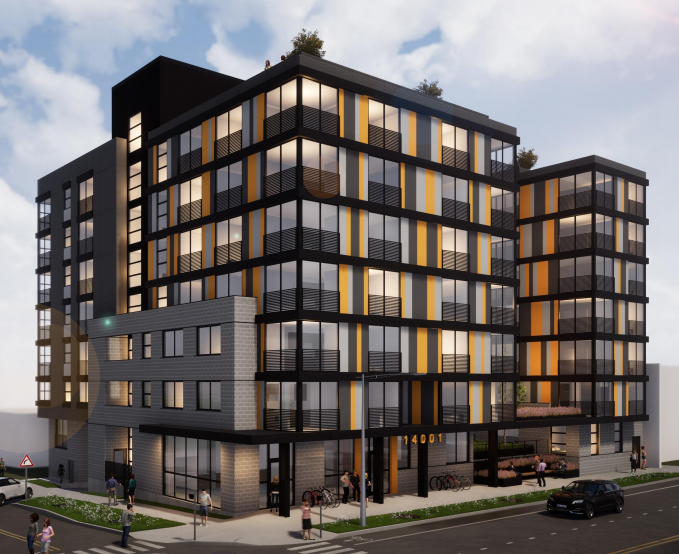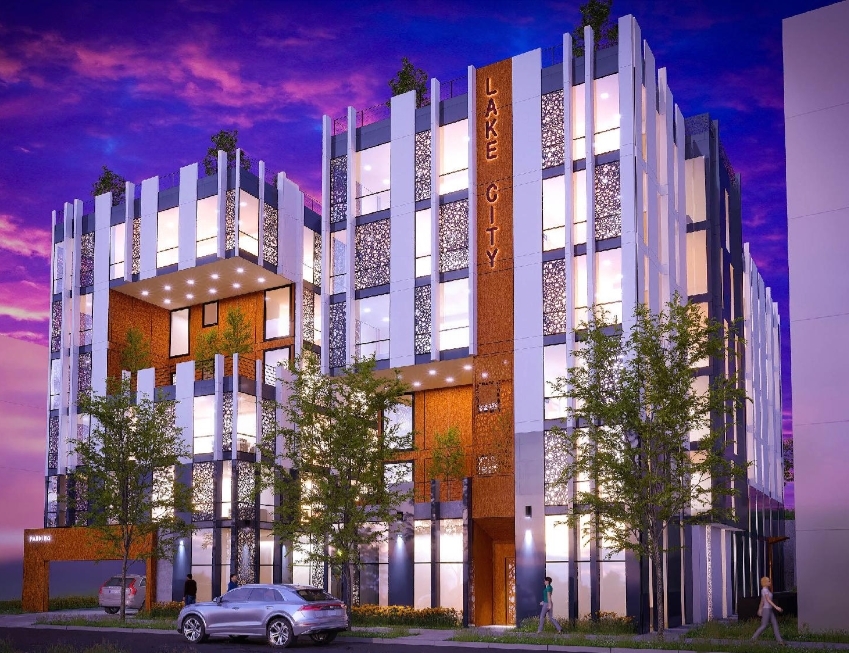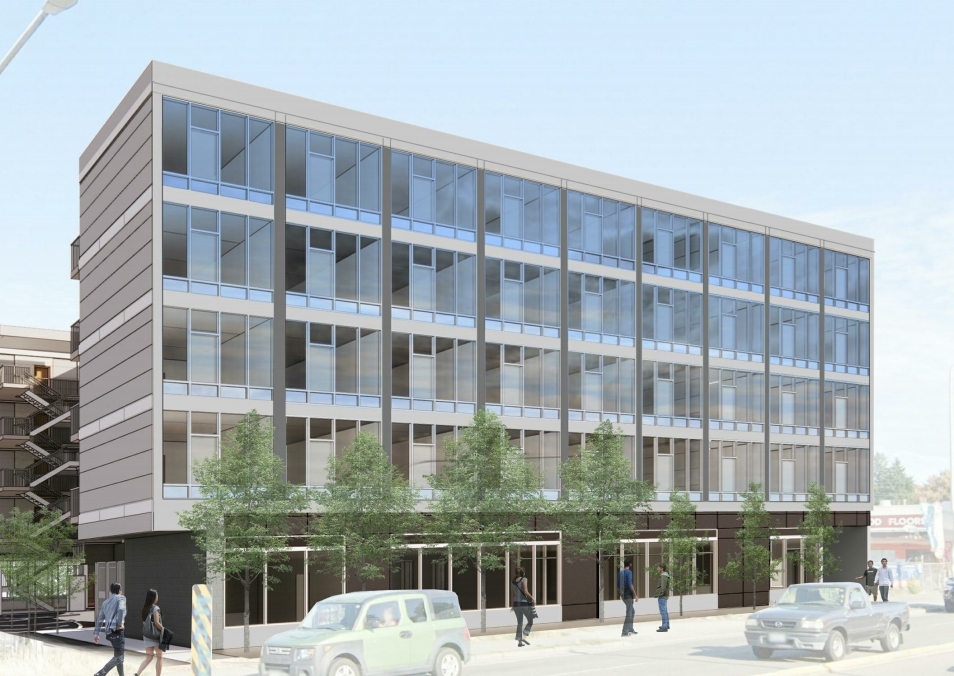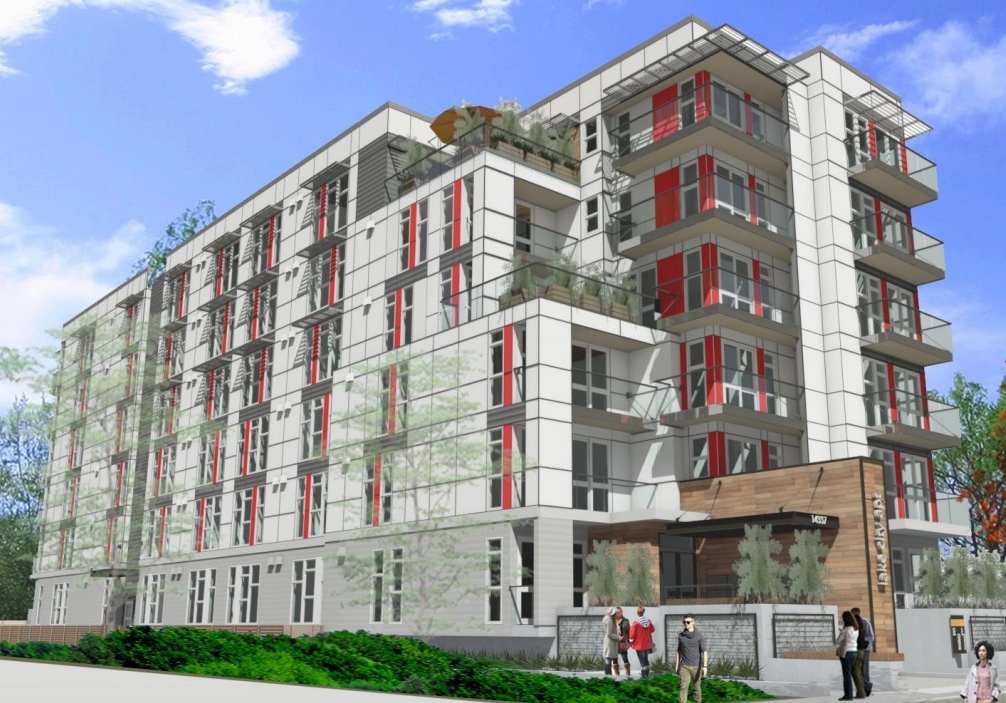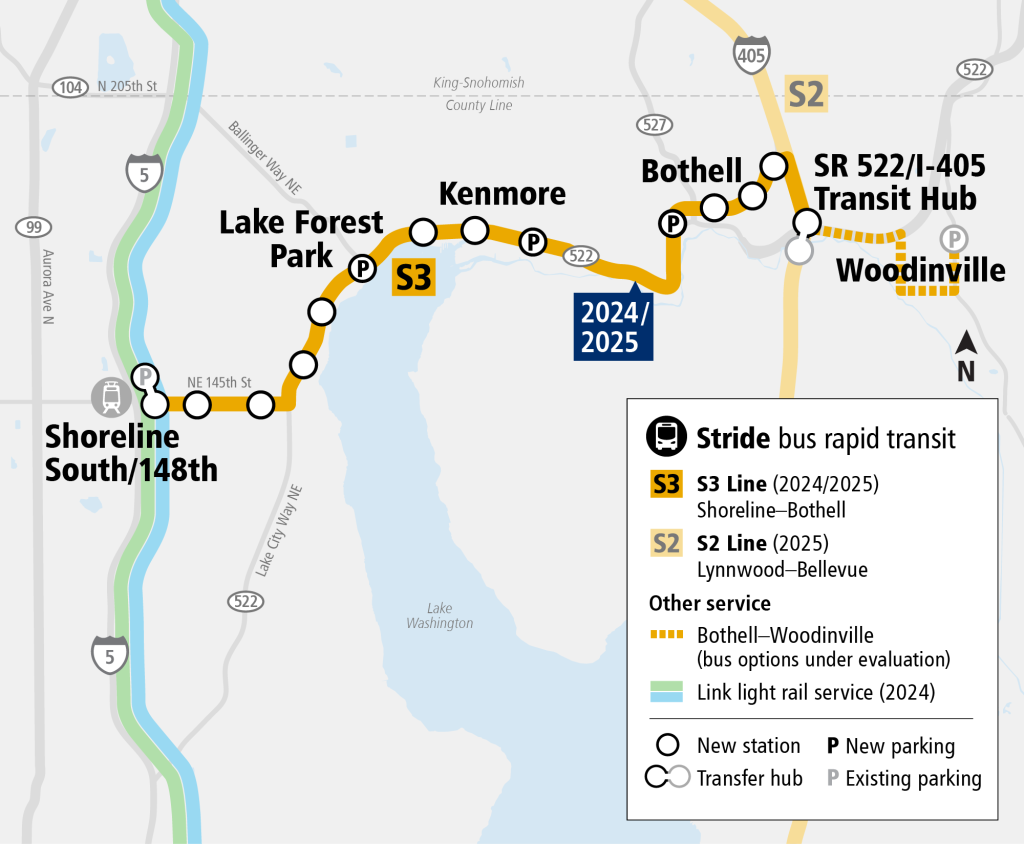Long predominantly flanked by auto dealerships and auto shops, parking lots, and single-family homes, Lake City Way is seeing an influx of multifamily development. This corridor links the Lake City hub urban village with Roosevelt and Seattle’s northeastern suburbs. Upzoned in 2019 when Mandatory Housing Affordability (MHA) went citywide save for single-family zones, the City now allows the vast majority of the corridor to develop taller residential and commercial buildings.
Three segments of the corridor can be identified by the extent of their zoning. Between exiting I-5 on to Lake City Way and to the border of the Lake City urban village, here you find the most conservative and anemic zoning on the corridor. Next and as the name suggests, the Lake City hub urban village is home to the widest and more liberal zoning on the corridor. Lastly, after we leave the urban village and before leaving Seattle there exists zoning that looks like a middle ground between the first two segments. Development along these segments is proportional with the zoning, with development slow as we start in the south.
A slow lead up to the Lake City Urban Village
Only one significant multifamily construction has taken place on the southern portion of the Lake City Way corridor. Completed in 2018, Sedona apartments’ construction at 8500 20th Ave NE added a six-story 215-unit mixed-use building to the city. Sixteen townhouses, live/work units, and three boarding houses were also a part of the scope of the project. Even with the limited zoning on this part of the corridor, Sedona should be joined be other tall multifamily buildings. Multiple car dealerships, parking lots, and old buildings on the segment share Sedona’s C1-75 (M) zoning designation. At 10516 Lake City Way NE, there are substantial alterations to a retail store that would convert it into an 18-unit apartment building that is currently under inspection.
While non-lowrise multifamily is taking time to pop up on the segment, townhouses sure have been proliferating. Hard not to spot in the past few years was the construction of 87 townhouses at the Ravenna88 site — located at the intersection of Lake City Way NE and NE 88th St — that wrapped up in 2020. Just east of Sedona, 24 townhouses are near completion or complete. At 8617 20th Ave NE, seven are proposed to replace an old and small apartment building. Other small unit developments include three live/work units proposed at 8251 Lake City Way NE, and an auto repair shop to brewery conversion is proposed at 1409 NE 80th St.
Urban Village Construction Booms
True to its “hub” designation, the Lake City urban village is the epicenter of construction activity on the corridor. The urban village has been seeing its share of multifamily development in the past few decades, but permitting and construction activity has picked up. Based on the liberal zoning, there’s still plenty of underutilized space to alleviate our housing crisis with.
- The latest additions to Lake City urban village’s multifamily buildings and proposed additions, sorted south to north, include:
- 12311 32nd Ave NE – Origin Apartments: a seven-story 144-unit mixed-use building with nine live/work units, and parking for 154.5 vehicles. Completed in 2017.
- 12320 32nd Ave NE – A six-story 100-unit apartment building with two commercial units. In permitting process, no ground broken or demolition of existing building.
- 12328 33rd Ave NE – A four-story 46-small unit apartment with 50 bicycle parking spaces. In permitting process.
- 12337 30th Ave NE – Amalfi Apartments: a seven-story 130-units apartment with 51 parking spaces and 117 bicycle parking spaces. In permitting process, recently called back for additional design review.
- 12350 33rd Ave NE – A four-story 23-units apartment building. Completed in 2015.
- 3300 NE 125th St – A six-story congregate residence with 150 bedrooms, 2,222 square feet of retail space, 1,985 square feed of live/work units, and 51 parking spaces. Under construction.
- 12548 Lake City Way NE – Polaris at Lake City: A two, six-story apartment building (257 low-income family units total) with 68 park spaces proposed, 276 bicycle parking spaces, office, and retail. Under construction.
- 2820 NE 127th Street – The Tony Lee: a six-story 70-unit (69 affordable) mixed-use project, with commercial space dedicated to a preschool. Completed in 2018.
- 12706 33rd Ave NE – The Artisan Apartments: a seven-story 159-unit mixed-use apartment building with five commercial spaces, and up to two of those five can be used as live/work units. In permitting process.
- 12727 30th Ave NE – The Caspian: a seven-story, 210-unit congregate residence for the neuro-diverse with 78 bicycles parking spaces. In permitting process.
- 3025 NE 130th St – Mysa Lake City Apartments: a seven-story 118-unit with 82 parking stalls. Completed in 2019 with five townhouses as a part of the project.
Townhouses aren’t a unique development to the Mysa Lake City Apartment in the urban village, namely a project proposing 43 townhouses at 3500 NW 125th St is making its way through permitting. Smaller townhouse projects are also progressing, with examples like 12036 33rd Ave NE, 12541/12547 35th Ave NE, and 12554 A 35th Ave NE. Uncommon to the city is an eight-unit rowhouse development under construction at 12004 31st Ave NE that is also happening in the urban village.
On our way out of Seattle
Leaving the urban village and heading farther north, we finally begin to approach a future transit project of the likes that we should expect running along a corridor like Lake City Way, which doubles as SR-522. Instead of staying on SR-522, the SR-522/NE 145th Stride bus rapid transit (BRT), as its current name suggests, will turn on NE 145th St rather than continue onto Lake City’s portion of SR-522. Nevertheless, some of the projects on the northernmost segment of Lake City Way will have easy access to the future BRT line that will also connect the area to the future NE 148th St light rail station.
The handful of projects on this segment include:
- 3031 NE 137th St – The Chameleon Apartments: nine units added with interior alteration within existing apartment. Completed in 2019.
- 14005 Lake City Way NE – A seven-story, 81-unit apartment building with one retail unit, 51 parking spots, and 73 bicycle parking spots. Permit issued.
- 14038/14040 Lake City Way NE – A six-story, 124-unit mixed-use building with two live/work units, one commercial unit, a rooftop greenhouse, 118 bicycle parking spots, and 28 car parking spots. In permitting process.
- 14315 Lake City Way NE – Sacred Medicine House: five-stories and 125 units of permanent supportive housing by Chief Seattle Club. 10 parking spots are being considered. In permitting, initially projected for late 2021 completion by Chief Seattle Club.
- 14337 32nd Ave NE – Lake City Apartments: a six-story, 71-unit — split between 42 small efficiency dwelling and 29 apartment — multifamily building with 25 parking spaces. Under construction.
What next for Lake City
With roughly 600 multifamily units constructed in the past few years and around 1,600 multifamily units/bedrooms either under construction and making their way through permitting, the Lake City Way corridor is certainly making a contribution to the city’s housing supply. It’s clear that this contribution is being constrained by the bottleneck that exists south of the urban village, where most of the corridor is terribly limited by constricted and conservative zoning. The sheer amount of townhouse development on the corridor is also contributing to the housing supply, but it could also be seen through the lens of locking in lowrise and low-density housing on the corridor for generations. My concern is especially heightened when that kind of housing is locked in on parts of the southernmost parts of the corridor.
That being said, townhouses are a type of missing middle housing — housing development that falls between single-family homes and mid-rise buildings — that the corridor could use next to its apartment building development. Aforementioned live/work and rowhouse developments also fall into that definition, further increase housing affordability, and diversify the housing options from just apartments and single family homes. To allow these housing types, the City should look to expand zoning on the corridor to allow lowrise missing middle housing within a 15-minute walkshed of Lake City Way. With increased housing supply, there would also be more impetus — as if the need didn’t already exist — to transform the road from a car-centic highway corridor toward a walkable street safe for pedestrians and better served by transit.
While several Metro routes run through the corridor, it’s rather clear that corridor would benefit from a major transit development to connect the new housing with the wider city. Shoreline’s apartment development is built around light rail and BRT, yet Lake City has neither aside from the stop on 145th that it’ll get from the SR-522 BRT. The neighborhood does trade Route 41 for a compelling Route 20 and light rail connections in the Northgate Link extension bus restructure, but this only really benefits the urban village. The outer segments will still suffer from limited transit service. Considering the zoning, the northernmost segment has the worst balance of increased housing supply and sparse transportation options. Whether it be the Lynnwood Link extension bus restructure or more proactive action, more transit service should be secured for the neighborhood.
With the pairing of being in North Seattle and a highway, the corridor also has very weak pedestrian infrastructure and safety conditions with its patchy sidewalk network and proximity to higher speed traffic. Consistent with transit service, pedestrian infrastructure also falls off north and south of the urban village. To encourage existing and new residents on the corridor walk to their neighbor amenities, basic pedestrian safety improvements and infrastructure like a complete sidewalk network should be pursued. Decreased speed limits, and more crosswalks would also be rudimentary improvements to encourage more trips to take place outside of cars.
Lake City Way is a symbol of car-centrism in Seattle with its many car dealerships, vast parking lots, and auto services. This is clearly changing, as old auto spaces are slowly being replaced with spaces for people. This change can be accelerated with liberalized zoning and transit/pedestrian investments, we just need the political will to make these investments.
Shaun Kuo is a junior editor at The Urbanist and a recent graduate from the UW Tacoma Master of Arts in Community Planning. He is a urban planner at the Puget Sound Regional Council and a Seattle native that has lived in Wallingford, Northgate, and Lake Forest Park. He enjoys exploring the city by bus and foot.

